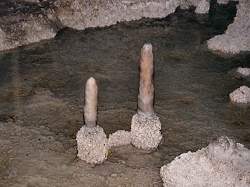König-Otto-Tropfsteinhöhle mit Adventhalle
King Otto Dripstone Cave with Advent Hall
Useful Information

| Location: | A3 exit Velburg, 3 km Richtung Velburg, links ab 3 km Richtung Reichertswinn, rechts ab 3 km bis St. Colomann. Ab Velburg gut ausgeschildert. 50 km NW Regensburg and 50 km SEE Nürnberg. (49°15'16.33"N, 11°41'24.25"E) |
| Open: |
APR to OCT daily 9-17, last tour 16:15. In winter groups (20+) after appointment. [2007] |
| Fee: |
Adults EUR 2.60, Children (5-14) EUR 1.60, Children (0-4) free. Groups (20+): Adults EUR 2.30, Children (5-14) EUR 1.30. [2007] |
| Classification: |
 Karst cave
Malm (Dolomit) Karst cave
Malm (Dolomit)
|
| Light: |
 Incandescent Electric Light System Incandescent Electric Light System
|
| Dimension: | - |
| Guided tours: | D=30 min, V=23,000/a [2005]. |
| Photography: | |
| Accessibility: | |
| Bibliography: | - |
| Address: |
Stadt Velburg, Verkehrsamt, Hinterer Markt 1, 92355 Velburg, Tel.: +49-9182-9302-0, Fax: +49-9182-9302-44.
E-mail: |
| As far as we know this information was accurate when it was published (see years in brackets), but may have changed since then. Please check rates and details directly with the companies in question if you need more recent info. |
|
History
| 30-SEP-1895 | discovery and first exploration. |
| 1954 | electric light. |
| 02-DEC-1972 | discovery of the Adventhall on the first Advent. |
Description

The König-Otto-Tropfsteinhöhle (King Otto dripstone cave) is located near Velburg in the Oberpfalz, on the Fränkische Alb plateau (Frankian Jura). The plateau is hilly, some of the hills have dolomite rocks on top, which were often used to build castles. The hills are the remains of petrified reefs, which resist weathering better than sedimentary limestone. Also this hills are much less fertile, so they are used for forestry. Towns and agriculture take place in the valleys and plains in between. Inside such a forest covered hill, close to the town St. Colomann is the location of the König-Otto-Tropfsteinhöhle.
The cave was named after the bavarian King Otto I., as it was discovered on his saint's day, the 30-SEP-1895. The story goes, that the shepherd Peter Federl hunted a fox. When this fox disappeared inside the hillside, he followed him and entered the cave. The legend does not tell much details, but it seems the entrance already existed, although it was probably never noticed.

The new discovered cave was developed immediately and opened to visitors. The works included the construction of paths and the widening of narrow passages. Also, as typical for this area, some speleothems were crashed to make way for the path. After this works, the cave was visited using candles, torches and magnesia. Unfortunately all those light sources produce a decent amount of grime, which covered the whole cave including the speleothems. This part of the cave is today black and unappealing.
But this gives an impressive contrast to the 1972 new discovered Adventhalle (Advent Chamber). It was named after its discovery on the first Advent. The special feature of this chamber are its speleothems, among them dogtooth spars, cave pearls and even some helictites.
In contrary to most other cave discoveries, this one was not by accident.
This new parts was systematically sought after by Helmut Schlierf and Michael Kirnberger from Fürth, two members of the Nuremberg caving club
 Forschungsgruppe Höhle und Karst Franken.
They explored the cave very intensive and then dug at the most promising places, at a time when this tactic was generally unknown in Germany.
Forschungsgruppe Höhle und Karst Franken.
They explored the cave very intensive and then dug at the most promising places, at a time when this tactic was generally unknown in Germany.
The new chamber is extraordinary. It was covered by a cave lake for a very long time, and the water deposited calcite crusts all over. In opposition to dripstones with rather smooth surface, this calcite is formed of single growing crystals which are also called dogtooth spars. At the surface of the water the amount of deposited calcite is pretty high. This results in so called water level marks, horizontal deposits of limestone marking the former water level. Stalagmites which grew on dry ground and then get partly covered by a cave lake get a certain look: they are covered by calcite crystals at the foot.

|
| König-Otto-Tropfsteinhöhle Gallery |
- See also
 Search Google for "König Otto Höhle"
Search Google for "König Otto Höhle" Google Earth Placemark
Google Earth Placemark Die König-Otto-Höhle bei Velburg /Fränkische Alb (visited: 28-JUL-2011) definitely the most detailed and most interesting page about this cave on the net, made by Franz Lindenmayr. (
Die König-Otto-Höhle bei Velburg /Fränkische Alb (visited: 28-JUL-2011) definitely the most detailed and most interesting page about this cave on the net, made by Franz Lindenmayr. ( )
) König-Otto-Tropfsteinhöhle, the cave history in a pdf file. (
König-Otto-Tropfsteinhöhle, the cave history in a pdf file. ( )
) König-Otto-Tropfsteinhöhle, some information by the county. (
König-Otto-Tropfsteinhöhle, some information by the county. ( )
) König-Otto-Tropfsteinhöhle (
König-Otto-Tropfsteinhöhle ( )
)
 Index
Index Topics
Topics Hierarchical
Hierarchical Countries
Countries Maps
Maps Search
Search